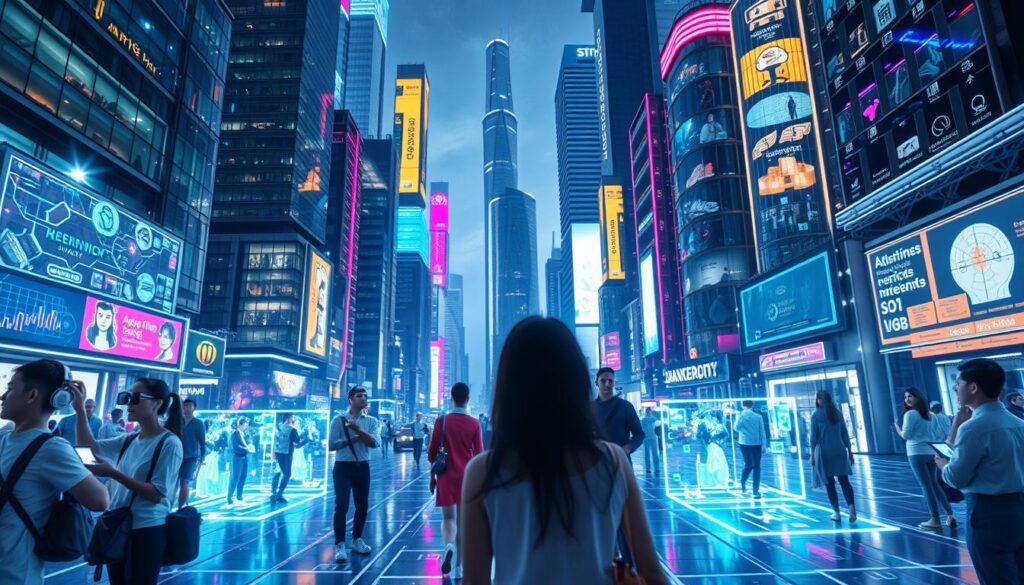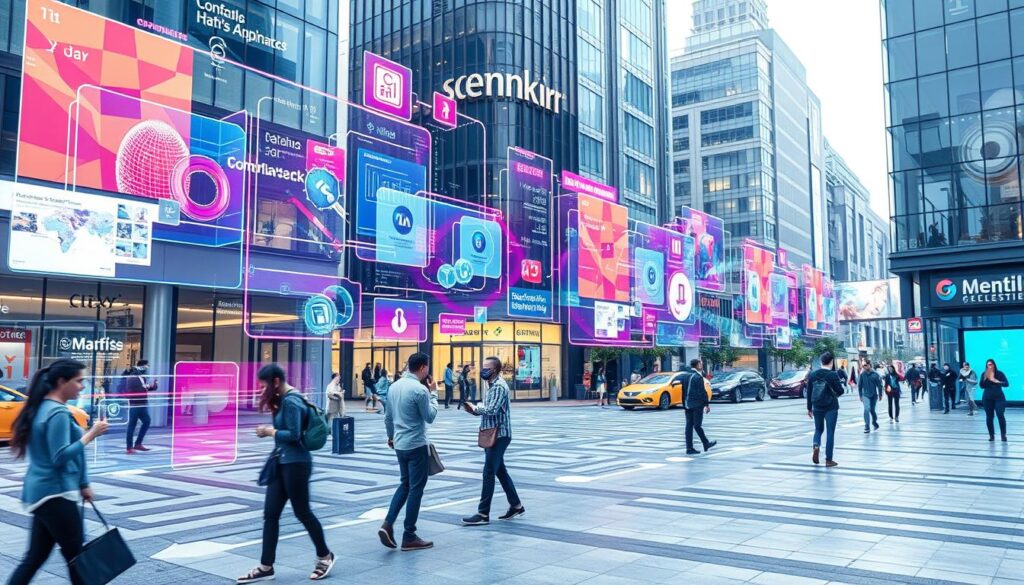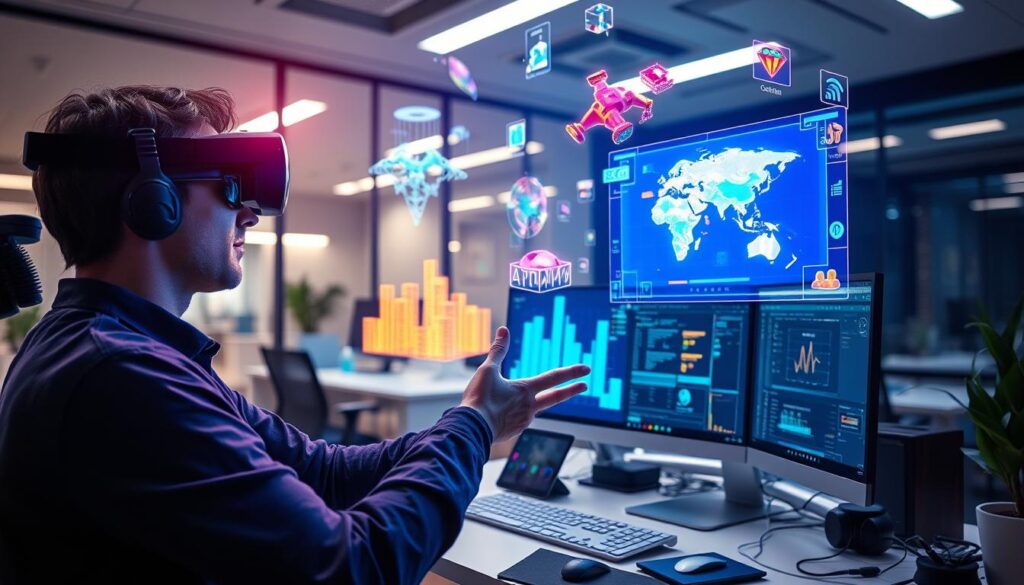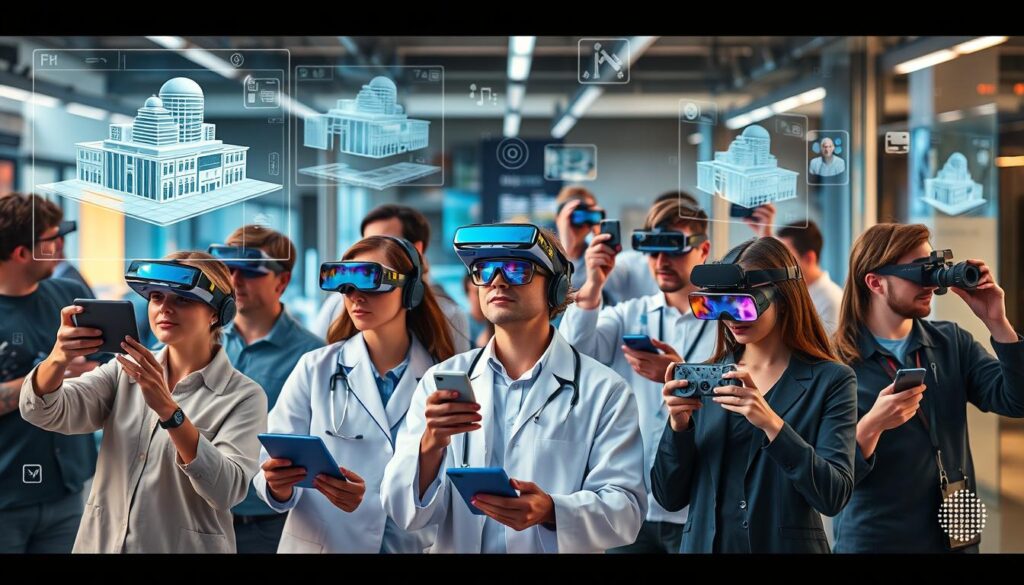FTC disclaimer: This post contains affiliate links and I will be compensated if you make a purchase after clicking on my link.
Are you ready to unlock the power of augmented reality (AR)? It’s changing how we interact with the digital world. AR software is now a big deal, changing many fields like gaming and healthcare.
But, with so many choices, picking the right AR tools can be tough. In this guide, we’ll look at the top AR software and apps. They’re changing how we experience things and driving new ideas in many areas.
Key Takeaways
- Discover the most powerful and versatile augmented reality software for your business or creative projects.
- Learn how AR technology is transforming industries and enhancing user experiences across gaming, education, healthcare, and more.
- Explore the latest features and capabilities of leading AR development tools, content creation platforms, and mobile apps.
- Understand the benefits of incorporating augmented reality into your workflows, from improved visualization to increased efficiency.
- Find the right AR software to fit your budget and technical requirements, whether you’re a professional or a beginner.
Overview of Augmented Reality Software
What is Augmented Reality Software?
Augmented reality (AR) software mixes digital stuff with our view of the real world. It uses 3D models and live video to make things interactive. Users can play with virtual objects in their space.
AR software uses smart algorithms to understand what we do. It shows visuals that change with our movements. This is thanks to motion-tracking tech.
How Augmented Reality Software Works
The main parts of AR software are Augmented Reality Technology, AR Visualization, Real-Time Video Streaming, Motion Tracking, and Gesture Control. These work together to show digital stuff on top of the real world. This makes for a fun, interactive experience.
AR software uses cool computer vision to see what’s around us. It finds surfaces and objects, then adds virtual stuff that looks like it’s really there. This all happens fast, changing as we move.
With motion tracking and gesture control, we can play with the virtual stuff. This makes the real and digital worlds feel like they blend together. It’s a fun way to see and interact with our surroundings.
“Augmented reality is being developed and applied in pretty much every industry.”
– Tim Cook, CEO of Apple

Why Use Augmented Reality Software?
Augmented reality (AR) software brings many benefits to your business. It adds digital info to the real world. This can lead to increased engagement, better customer support, and cost savings.
AR software grabs users’ attention, making them more engaged and loyal. It creates a special bond between your brand and people. This makes your products or services more fun and memorable.
AR also helps save money. It cuts down on the need for physical samples, demos, and big ads. Customers can try out your products virtually, saving you money while still giving them a great experience.
AR can also make customer support better. It lets customers see how products fit in their space and get help right away. This can lower support tickets and make customers happier.
Using AR software can really boost your brand awareness and revenue. It makes your offerings stand out with unique and fun experiences. This grabs the attention and loyalty of your target audience.

Why Is Augmented Reality Software Important?
Augmented reality (AR) software changes how we see the digital and physical worlds. It mixes both, giving us a new way to experience things. AR is key in many areas, like education and business.
AR makes learning fun and easy. It brings school outside the classroom. Students can see 3D models and try interactive lessons. This makes learning better and more fun, helping them remember more.
In business, AR is very useful. It helps with better store layouts, custom support, and clear product views. This makes customers happier and saves money by reducing returns.
“AR technology has the power to bridge the physical-digital divide, empowering businesses and individuals to experience the world in new and innovative ways.”
AR also changes how we manage risks. It offers training in a safe, real-like setting. This helps workers learn and avoid mistakes, making everyone safer.
As AR gets better, its role will grow. Companies that use it will lead the way. They’ll offer better learning, work better, and manage risks well.

Features Offered by Augmented Reality Software
Augmented reality (AR) software has many features that make user experiences better. These features help unlock the full power of this new technology.
Augmented Visualization
Augmented visualization is a key feature of AR software. It mixes virtual objects and data with the real world. This makes experiences more fun and real.
Augmented Object Recognition
Augmented object recognition is another important feature. It uses computer vision to find and know physical objects. This lets the software show digital content that matches the objects.
AR software also has other cool features. For example:
- Augmented Navigation: It helps find your way in both the real and virtual worlds.
- Augmented Analytics: It shows real-time data and insights on top of the real world.
- Augmented Search: It lets you find and get digital content based on your location.
- Augmented Collaboration: It makes working together with remote teams easier.
These features of AR software let users mix the digital and real worlds. This opens up new ways to be more productive and have fun.
What Types of Users Can Benefit From Augmented Reality Software?
Augmented reality (AR) software changes how we see the digital and real worlds. It helps many users in different ways. AR is making things better for businesses, healthcare, and more.
Businesses use AR to show 3D models of products. This makes shopping more fun and cuts down on returns. AR also helps businesses learn more about their customers, making ads better and customers happier.
Manufacturers use AR to make production smoother and workers better trained. AR adds digital info to real places, helping to fix problems and cut down on mistakes.
Educators use AR to make learning fun and easy. AR helps students understand hard topics better and remember them longer.
Healthcare professionals use AR to show patient data during surgeries. This makes surgeries more precise and helps patients. AR also helps teams work together from far away.
Tourists and travelers get info about places with AR apps. This makes exploring new places easier and more fun.
The AR market is growing fast, expected to hit $97.76 billion by 2028. This means more people will benefit from AR in many fields.

How Much Does Augmented Reality Software Cost?
The price of AR Software Pricing changes a lot. Basic AR software for phones or tablets can cost from free to $10 a month. But, more advanced AR software with 3D models and custom graphics can be much pricier, especially for Enterprise AR Solutions.
Whether you pay once or by subscription also affects the cost. The AR App Development Costs can be between $20,000 and $200,000 or more. This depends on how complex the app is, the platform, and the services needed.
Startups and small to medium-sized businesses (SMEs) usually spend between $20,000 and $100,000 on AR apps. Big companies with lots of needs might spend over $100,000 or even hundreds of thousands of dollars. The number of AR users is expected to grow from 0.44 billion in 2019 to 1.73 billion by 2024.
The cost for AR app development varies based on complexity:
- Simple AR Application: $10,000 to $50,000
- Medium-sized AR Applications: $50,000 to $200,000
- Complex AR Applications: $250,000 to $800,000
Many things can affect AR App Development Costs. These include the app’s features, where it works, its design, content, backend, testing, AR SDKs, location services, real-time collaboration, and legal stuff. The hourly rates for AR app development also change by location. In North America, it’s $60 to $275 per hour. In India, it’s $10 to $120.
“The market for AR in healthcare was valued at $609.60 million in 2018 and is anticipated to grow to $4,237.60 million by 2026, at a CAGR of 27.4%.”
Best Augmented Reality Software
The augmented reality (AR) market is growing fast. It’s expected to hit $72.8 billion by 2024. Businesses and developers are looking for the best Top AR Software to make their experiences better. Many strong AR Development Frameworks and platforms are leading the way. They help speed up AR app development with their tools and features.
Unity is the most popular AR Platform, used in over 60% of mobile AR and VR content. It supports many platforms, has real-time 3D rendering, and comes with an AR SDK. Unreal Engine is known for its top-notch graphics and physics simulations. It’s great for creating detailed visuals.
React Native lets developers use their mobile app skills to add AR to their apps. It uses JavaScript and React patterns. This makes it easy to add AR to existing apps. These frameworks and platforms offer important features, support for many platforms, and lots of features. They help businesses and developers make cool AR apps.
| AR Software | Key Features | Pricing |
|---|---|---|
| Unity | Multiplatform support, real-time 3D rendering, integrated AR Foundation SDK | $40/user/month (billed annually) |
| Unreal Engine | Cutting-edge graphics, advanced physics simulations | Free to use |
| React Native | Leverages JavaScript and React for building AR experiences | Free to use |
| ARCore | Google’s free platform for developing AR apps on Android | Free to use |
| ARKit | Apple’s platform for creating AR apps on iOS devices | Free (Apple Developer Program: $99/year) |
With these AR Software and AR Development Frameworks, businesses and developers can make amazing AR experiences. These experiences are immersive, engaging, and innovative. They can really capture audiences and bring in real results.
Overlyapp: The Versatile AR Creator
Overlyapp is a strong AR software that lets users make cool AR experiences without coding. It’s easy to use, so businesses and creators can add AR to their stuff. This makes marketing and products better.
Overlyapp Augmented Reality Use Cases
Overlyapp is great for many things. It works well in e-commerce, construction, and education. Here’s how it can help:
- AR for E-commerce: It lets you show products in 3D. Customers can see how things look in their homes. This can lead to more sales and fewer returns.
- AR for Building Information Modeling (BIM): It helps with 3D building models. Architects and builders can work together better. They can share ideas more clearly.
- AR for Education: It makes learning fun. It brings hard ideas to life. Students learn better with interactive content.
- AR for Events and Marketing: It creates cool AR experiences. These can grab people’s attention at events and in stores. They help brands get noticed.
Overlyapp makes adding AR easy. It helps businesses and creators be more innovative. They can engage customers and make better choices in many fields.
3D Capture Apps: Polycam and Scaniverse
In the world of augmented reality, 3D capture apps are changing how we make and use digital stuff. Polycam and Scaniverse are leading the way. They let users make high-quality 3D models with their phones.
Polycam is a top app for Android, with a 4.2 rating from 19,000 reviews. People like James Mays say it’s easy to use. But, some find it hard to upload and process their scans. Andrew D. mentions a special export format in the free trial, but says you can change it with tools like Blender.
Scaniverse is known for its great 3D model capture. It makes it easy to turn your world into detailed 3D models. These models are perfect for AR Asset Development, 3D Model Creation, and more.
Both apps have great editing tools. They help users make their 3D captures better. This is great for augmented reality projects or sharing on Sketchfab. These apps are key for architects, designers, game makers, and artists who need top-notch 3D assets.
| App | Key Features | Pricing |
|---|---|---|
| Polycam |
|
|
| Scaniverse |
|
|
In the fast-changing world of augmented reality, Polycam and Scaniverse are top tools. They make creating and editing 3D content easy and precise. Whether you’re an architect, designer, or artist, these apps help bring your ideas to life digitally.
Pokemon Go: The AR Gaming Phenomenon
Launched in 2016, Pokemon Go is the most popular Augmented Reality Games of all time. It brings digital Pokemon into our world. Players see and interact with them using their phone’s GPS and camera.
The game’s huge success comes from its connection to the Pokémon franchise. It offers fans a fun and Immersive Experiences. Even though Niantic tried with Wizards Unite, Pokemon Go stands out as a top Augmented Reality Games.
- Pokemon Go had over 20 million active users in just 7 days after its release.
- The game has a significantly high user engagement rate, with users spending more time per day on it than on social media platforms like Facebook.
- A large portion of Pokemon GO players fall within the 18-24 age bracket, a demographic typically challenging to reach through traditional marketing methods.
- One pizza restaurant reported a 75% increase in revenue while utilizing Pokemon GO “lures” for marketing.
The success of Pokemon Go shows the power of Location-Based AR. It creates fun and Immersive Experiences. As tech gets better, we’ll see more Augmented Reality Games that mix our digital and physical worlds.
InCitu and ProtoArch: AR for Construction Planning
Augmented reality (AR) is changing how we see and plan construction and city planning. Two apps, InCitu and ProtoArch, are at the forefront of this change.
InCitu lets users see planned buildings in real life. It’s great for public talks, letting people share thoughts on new projects. It shows 3D models of buildings and more on top of real places, making it easy to see how things will look.
ProtoArch goes even further. It’s more precise and works well with detailed 3D models. Architects and city planners use it to show off projects and get feedback. It’s also good for learning and planning.
These apps are changing how we use AR for Construction, AR for City Planning, and more. They let users see and interact with plans in real life. This makes planning and building more open and efficient.
“These AR apps are revolutionizing the way we plan and present construction and urban development projects. They enable us to involve the community, identify potential issues, and make more informed decisions.”
AR is making a big difference in building and city planning. As the AR market grows, we’ll see even more cool uses. It will help us work together better and make smarter choices.
SAN: Immersive Augmented Reality Art Experiences
Unlock the power of augmented reality with SAN. This app changes how we see art. It was made by famous artist Gints Gabrāns. SAN brings you AR Art Installations that seem to defy gravity and scale.
Step into the world of Immersive Art Experiences. Here, digital art comes to life around you. With SAN, you can explore and play with these amazing creations. They mix the real and digital worlds seamlessly.
Whether you’re walking in the city or at home, SAN’s GPS-based AR lets you add art to your space. It’s a new way to see and enjoy art.
But SAN is more than just a place for digital art. It’s also a learning tool. It teaches you about art, tech, and creativity through Public Art. It lets you see the world in a new light.
Experience art in a new way with SAN. Here, Educational AR meets immersive tech for a unique journey. Let your creativity shine with SAN.
Fibbl: AR for Fashion and E-commerce
Fibbl is changing the game in fashion and e-commerce. It combines 3D and augmented reality (AR) in a new way. This makes shopping more fun and helps reduce returns.
Fibbl’s SaaS platform helps fashion brands and more. It works on all devices and offers top-notch visuals. This lets customers see products in their own space, helping them buy with confidence.
Fibbl’s tech is a big deal for fashion and retail. It worked with Sportland to make a big footwear collection. They use Sony’s A7R IV camera to make high-quality 3D models.
Fibbl’s tech does more than just make shopping better. It also helps brands save money and time. This is because it makes product images fast and easy.
Fibbl wants to do even more. They aim to build the biggest 3D model database for fashion. This will help shape the future of luxury shopping with AR for Fashion, AR E-commerce, 3D Product Visualization, and Virtual Try-On.
| Key Features | Benefits |
|---|---|
|
|
Fibbl is changing the fashion and e-commerce world. It offers a new way to shop, using AR for Fashion, AR E-commerce, 3D Product Visualization, and Virtual Try-On. This is how we’ll shop for luxury items in the future.
ClueKeeper: Location-Based AR Scavenger Hunts
Discover the magic of augmented reality (AR) with ClueKeeper. It turns simple scavenger hunts into exciting, location-based adventures. Perfect for educational AR, corporate team-building, or community events, ClueKeeper makes exploring fun.
ClueKeeper combines AR technology seamlessly. Players get clues and solve puzzles on their phones. This AR Scavenger Hunt method makes the game more exciting and interactive.
- Location-Based AR: ClueKeeper uses GPS for location-based AR adventures. It leads players on a digital hunt in real places.
- Customizable Clues: Creators can make different clues, like text, video, and AR. This keeps players engaged and challenged.
- Hint System: Players can buy hints to solve tough puzzles. This adds a strategic twist to the game.
- Playtesting: ClueKeeper makes sure the AR scavenger hunt works smoothly. They test it well to ensure a great experience.
ClueKeeper is great for any outdoor activity, educational AR project, or corporate team-building event. It brings your ideas to life with AR. Make your next scavenger hunt unforgettable with ClueKeeper.
MeasureKit: Precise AR Measurement Tool
Augmented reality (AR) apps like MeasureKit change how we measure things. They turn your phone or tablet into a precise tool. This is great for DIY projects, work, learning, and outdoor fun.
MeasureKit uses Apple’s ARKit to measure things around you. It’s perfect for home fixes, work projects, or measuring trees on hikes. This app has you covered.
The app is easy to use. It lets you measure lengths, distances, angles, and more. No need for old tape measures anymore.
MeasureKit is also good for school and outdoor activities. Students can learn by doing. Hikers and campers can plan better with it.
But, MeasureKit isn’t perfect. It might not be as accurate as real tools. For important jobs, use a tape measure or other tools.
MeasureKit is a great app for measuring things. It’s useful for many activities. It helps you make better choices and do projects with confidence.
“MeasureKit has been a game-changer for my home renovation projects. The app’s AR-powered measurement tools make it easy to plan and execute my DIY tasks with precision.”
Key Features of MeasureKit
- Accurate AR-powered measurement tools for length, distance, angle, area, and volume
- Intuitive user interface for quick and easy measurements
- Suitable for DIY and home improvement, professional applications, education, and outdoor activities
- Integration with iPhone and iPad lidar scanners for enhanced measurement accuracy
- Continually updated with improvements to room scanning quality and measurement precision
MeasureKit is great for many things. It’s perfect for home projects, work, or school. It makes measuring easy and fun. Try it out for yourself.
EyeJack: Immersive Art and Creator Tools for AR
In the world of AR Art Experiences, EyeJack is a top choice. It lets artists and creators make their digital dreams real. This app turns animations and videos into AR Art Experiences that you can see and play with through the EyeJack app.
EyeJack’s AR Creator Tools are easy to use. They help artists make interactive AR experiences. You can add images, text, emojis, and videos to your art. This makes Digital Art Exhibitions more fun and engaging.
EyeJack also works with Metaverse AR Projects. For example, it has Neonz, a set of special avatars for an AR metaverse. This shows how EyeJack is creative and adaptable.
EyeJack has grown a lot, with over 10,000 artists and fans. In 2021, it launched Prosthetic Reality v:2. This update had 65 artists and a new Web 3 layer, opening up more possibilities for digital art.
| Feature | Description |
|---|---|
| Trigger-less AR | EyeJack’s surface tracking technology eliminates the need for trigger images, allowing for a more seamless and accessible AR experience. |
| Artistic Versatility | The app enables artists to transform animations and video files into immersive AR artworks, empowering them to showcase their digital creations in engaging and interactive ways. |
| Metaverse Integration | EyeJack’s Neonz project explores the intersection of AR technology and the emerging metaverse, offering unique avatar experiences for users. |
EyeJack is changing the game with its easy tools, cool AR features, and wide range of uses. It’s a key place for artists, creators, and fans to explore and create in the world of AR Art Experiences, AR Creator Tools, Digital Art Exhibitions, and Metaverse AR Projects.
“EyeJack has been a game-changer for me as an artist. The ability to transform my work into immersive AR experiences has opened up a whole new world of creative expression and audience engagement.”
– Jane Doe, Digital Artist
Conclusion
Augmented reality software has grown a lot. It’s used in many fields like gaming, e-commerce, and construction. Top AR software like Unity and Unreal Engine help make these experiences better.
As more people use AR, its role will grow even bigger. This means new chances for innovation and change in many areas. The future of AR looks very promising, and it’s important for everyone to keep up with it.
The growth of AR software is amazing. It’s used in many ways, like in retail for trying out products virtually. Over 8,500 apps use the MAXST AR SDK, showing AR’s success. With better tools from ARCore and ARKit, making AR experiences is getting easier for everyone.








